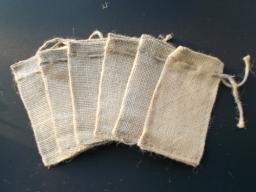

Plastic has become such a central part of modern living that imagining a world without it feels almost impossible. From grocery bags to packaging, storage, and household items, plastic dominates daily life. However, the environmental cost of this convenience is staggering—landfills are overflowing, oceans are polluted, and wildlife is suffering. As the search for sustainable alternatives intensifies, many are turning their attention to one humble solution: burlap sacks. But can these natural, eco-friendly bags truly replace plastic in everyday use?
In fact, burlap sacks are already proving to be a versatile and practical replacement in many areas. Made from jute, a natural and biodegradable fiber, burlap is sturdy, breathable, and reusable. Unlike plastic, which can take centuries to break down, burlap decomposes naturally, returning to the earth without leaving toxic residues. For people concerned about reducing their plastic footprint, burlap sacks offer a simple yet impactful alternative. But the question remains—are they practical enough to substitute for plastic in all the ways we currently depend on it?
One of burlap’s strongest qualities is its durability. These sacks are tough enough to hold heavy items such as grains, produce, or even tools without tearing. Unlike flimsy single-use plastic bags, burlap sacks can be reused countless times. Farmers and gardeners have long relied on them because they allow air circulation, preventing moisture buildup and keeping goods fresh for longer. This makes burlap a perfect choice for produce storage, where plastic often fails by trapping humidity and accelerating spoilage.
Additionally, burlap offers a rustic, natural aesthetic that has gained popularity in recent years. From reusable shopping bags to decorative storage solutions in homes, burlap has found its way into both practical and stylish applications. As consumers become more eco-conscious, the appeal of carrying a natural fiber bag instead of plastic grows even stronger.
If we imagine replacing plastic with burlap in daily life, the possibilities are surprisingly vast:
Shopping bags: Burlap totes can easily replace plastic shopping bags, offering strength and reusability.
Food packaging: Bulk items like rice, potatoes, onions, and coffee beans can be stored in burlap without risk of contamination.
Storage: Around the house, burlap sacks can be used to organize toys, laundry, or gardening supplies.
Event décor: Burlap has become trendy in weddings and events as a decorative, reusable material for table settings, banners, and more.
In these areas, burlap already proves itself to be a worthy substitute. However, it’s not without its limitations.
While burlap is an eco-friendly hero in many contexts, it cannot fully replace plastic everywhere. Plastic’s versatility comes from its resistance to water, flexibility, and ability to form airtight seals—qualities burlap lacks. For example, packaging liquids, sealing perishable items, or creating lightweight waterproof containers is difficult with burlap. If burlap were to completely replace plastic, additional treatments (like waterproof linings) would be necessary, which might compromise its biodegradability.
Cost is another factor. Burlap sacks are more expensive to produce than cheap, mass-produced plastic bags. While prices could drop with increased demand, the initial transition could discourage widespread adoption, especially in lower-income communities.
Rather than expecting burlap to replace plastic entirely, it may be more practical to view it as a complementary solution. Plastic has unique advantages that are difficult to replicate, but burlap shines in areas where breathability, durability, and biodegradability are more important. For example, groceries, bulk goods, and storage can all shift toward burlap, while areas that demand waterproof or airtight materials might continue to rely on other sustainable innovations.
In this sense, burlap is not the “silver bullet” for plastic pollution but part of a larger ecosystem of sustainable alternatives. When combined with paper, glass, metal, and new biodegradable plastics, burlap helps form a multi-pronged approach to reducing our reliance on traditional plastic.
Even if burlap cannot replace plastic completely, adopting it in everyday life has significant environmental benefits. Every burlap sack used instead of a plastic bag reduces the amount of non-biodegradable waste entering landfills and waterways. Since jute is a renewable crop, growing it also supports sustainable agriculture. In fact, jute cultivation improves soil fertility and absorbs carbon dioxide, making it one of the most eco-friendly fibers available.
By making small changes—like carrying a burlap shopping bag instead of accepting plastic at the store—individuals can collectively create a meaningful environmental impact. Over time, these shifts can drive larger industries to embrace sustainable packaging solutions, leading to systemic change.
As awareness about the dangers of plastic pollution spreads, demand for alternatives like burlap sacks will continue to rise. Governments are already implementing bans on single-use plastics in many parts of the world, creating more opportunities for natural materials to take center stage. Innovation may also improve burlap’s functionality, with waterproof coatings made from plant-based materials or blends with other biodegradable fibers enhancing its usability.
The future may not be entirely plastic-free, but it can certainly be less plastic-dependent. Burlap, with its strength, reusability, and eco-friendly nature, has an important role to play in this transition. By embracing it where practical, consumers can reduce their reliance on harmful plastics without sacrificing convenience.
Can burlap sacks replace plastic in everyday use? The answer is both yes and no. Burlap can’t match plastic’s versatility in every situation, but it offers a sustainable and practical alternative in many areas—especially shopping, storage, and packaging dry goods. Instead of expecting burlap to do it all, the smarter approach is to integrate it into our lives wherever possible, using it alongside other eco-friendly options.
Ultimately, the journey to a sustainable future will not rely on a single material replacing plastic but on a collective shift toward smarter, greener choices. Burlap is one of those choices, and embracing it today can help pave the way for a cleaner, healthier planet tomorrow.
| No comments yet. Be the first. |